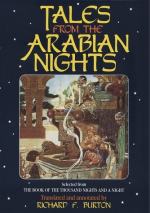The mention of wine in The Nights, especially the Nabiz or fermented infusion of raisins well known to the prae-Mohammeden Badawis, perpetually recurs. As a rule, except only in the case of holy personages and mostly of the Caliph Al-Rashid, the “service of wine” appears immediately after the hands are washed; and women, as well as men, drink, like true Orientals, for the honest purpose of getting drunk-la recherche de l’ideal, as the process has been called. Yet distillation became well known in the fourteenth century. Amongst the Greeks and Romans it was confined to manufacturing aromatic waters, and Nicander the poet (B.C. 140) used for a still the term , like the Irish “pot” and its produce “poteen.” The simple art of converting salt water into fresh, by boiling the former and passing the steam through a cooled pipe into a recipient, would not have escaped the students of the Philosopher’s “stone;” and thus we find throughout Europe the Arabic modifications of Greek terms Alchemy, Alembic (Al- ), Chemistry and Elixir; while “Alcohol” (Al-Kohl), originally meaning “extreme tenuity or impalpable state of pulverulent substances,” clearly shows the origin of the article. Avicenna, who died in A.H. 428 = 1036, nearly two hundred years before we read of distillation in Europe, compared the human body with an alembic, the belly being the cucurbit and the head the capital:-he forgot one important difference but n’importe. Spirits of wine were first noticed in the xiiith century, when the Arabs had overrun the Western Mediterranean, by Arnaldus de Villa Nova, who dubs the new invention a universal panacea; and his pupil, Raymond Lully (nat. Majorca A.D. 1236), declared this essence of wine to be a boon from the Deity. Now The Nights, even in the latest adjuncts, never allude to the “white coffee” of the “respectable” Moslem, the Raki (raisin-brandy) or Ma-hayat (aqua-vitae) of the modern Mohametan: the drinkers confine themselves to wine like our contemporary Dalmatians, one of the healthiest and the most vigorous of seafaring races in Europe.
Syphilis also, which at the end of the xvth century began to infect Europe, is ignored by The Nights. I do not say it actually began: diseases do not begin except with the dawn of humanity; and their history, as far as we know, is simple enough. They are at first sporadic and comparatively non-lethal: at certain epochs which we can determine, and for reasons which as yet we cannot, they break out into epidemics raging with frightful violence: they then subside into the endemic state and lastly they return to the milder sporadic form. For instance, “English cholera” was known of old: in 1831 (Oct. 26) the Asiatic type took its place and now, after sundry violent epidemics, the disease is becoming endemic on the Northern seaboard of the Mediterranean, notably in Spain and Italy. So small-pox (Al-judri, vol. i. 256) passed over from Central Africa to Arabia in the year of Mohammed’s




